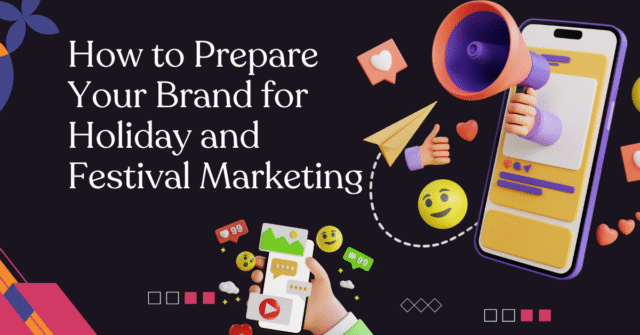With the holiday season and festival timeframes just around the corner, it’s critical for brands to craft an effective marketing strategy to make the most of this lucrative period. For businesses, the holidays mean more than just good cheer; they mean opportunities to connect with their audience, boost visibility, and supercharge sales. But jumping into holiday marketing without proper preparation can leave your campaigns falling short.
This blog is your ultimate guide to preparing your brand for holiday and festival marketing. From crafting compelling offers to making your customers feel heard, we’ll walk through the best ways to execute a winning strategy and make this season your most successful yet.
Why Holiday Marketing is Mission-Critical for Brands
The holiday season holds immense potential for businesses of all sizes. Here’s why it matters:
- High buying intent: Consumers are actively searching for gifts, celebration essentials, and deals, making them more likely to engage and convert.
- Emotion-driven purchases: The emotional vibe of holidays encourages people to spend on thoughtful items or experiences.
- Enhanced brand visibility: With people browsing more, your brand has a stronger chance of becoming part of their consideration set.
However, the competitive landscape can be fierce. Successfully capturing consumer attention during this period requires planning, relevance, and creativity.
Step 1: Define Your Goals and Objectives
Before anything else, establish clear goals for your holiday marketing campaigns. What outcomes are you aiming for? The following targets are common marketing objectives during the holiday season:
- Boost sales through time-sensitive promotions or product bundles.
- Building brand awareness among new audiences.
- Increasing customer retention by rewarding loyalty.
- Driving traffic to physical stores or e-commerce sites.
Ensure these goals are tied to measurable metrics such as sales growth percentage, social media engagement rates, or increased website traffic.
Step 2: Research and Understand Your Holiday Audience
Your audience’s behavior, preferences, and motivations tend to shift during the holidays. Understanding those dynamics can set your campaigns apart. Here’s how to gain valuable insight:
- Segment your audience by demographics, purchase history, or seasonal preferences. For example, differentiate between gift shoppers and those looking for personal purchases.
- Analyze past data. Look at your sales data from previous holiday seasons to identify top-selling products or successful campaigns.
- Conduct surveys or polls. Ask customers directly about their holiday shopping habits or what they’d like to see this festive season.
- Monitor trends. Use social listening tools to discover what’s trending within your industry or audience, such as popular holiday themes or products.
Step 3: Plan Promotions and Deals Strategically

Promotions and discounts are the bread and butter of holiday marketing. However, it’s essential to design offers that feel genuine and showcase unique value. Consider these options for your campaigns:
- Time-sensitive discounts (“Today Only!” or “Weekend Flash Sale”) to drive urgency.
- Product bundles that create value for gift shoppers. For example, pairing complementary items at a discount.
- Free shipping perks for online customers, especially for the last-minute shoppers.
- Early bird specials. Reward loyal customers or early buyers with exclusive discounts before the peak season begins.
Highlight these deals prominently on your website, email newsletters, and social media ads to ensure your audience doesn’t miss them.
Step 4: Optimize Your E-Commerce and Checkout Experience
Online shopping peaks during holiday seasons, which means your website needs to be ready for increased traffic. Here’s how to optimize it:
- Ensure speedy performance to prevent cart abandonment due to slow load times.
- Highlight holiday-specific categories. Create sections like “Holiday Deals,” “Gifts Under $50,” or “Stocking Stuffers” in your online store.
- Streamline the checkout process. Reduce unnecessary steps and clearly display total costs (including shipping).
- Offer multiple payment options. Make checkout as flexible as possible with payment providers like PayPal, Apple Pay, or even Buy Now, Pay Later options.
- Provide clear shipping deadlines. Transparency around delivery dates boosts customer confidence, especially for last-minute shoppers.
Step 5: Create Holiday-Themed Content
Content marketing plays a huge role in connecting with your audience during festivals and holidays. Keep your content engaging and tailored to seasonal themes:
- Holiday gift guides. Help customers by curating gift suggestions for different recipients (e.g., “5 Perfect Gifts for Your Tech-Loving Friend”).
- Festive how-tos. Share tips or tutorials that tie to your products, like “How to Create the Ultimate Christmas Gift Basket.”
- Behind-the-scenes content. Show the human side of your brand by sharing your team’s holiday celebrations or product preparations.
- User-generated content campaigns. Encourage customers to share photos using your products with a festive hashtag for a chance to win prizes.
High-quality visuals, cheerful tones, and holiday-specific hashtags (#HolidayDeals2025, #FestiveShopping) can amplify engagement further.
Step 6: Leverage Email and Social Media Campaigns
Email and social media are essential channels for amplifying your holiday marketing strategy. Here’s how to use them effectively:
Email Marketing Tips:
- Send personalized holiday greetings and recommendations based on user preferences or purchase history.
- Schedule countdown emails for limited-time sales or restocks to create urgency.
- Incorporate exclusive subscriber discounts to encourage repeat purchases.
Social Media Strategies:
- Create Instagram Stories or reels showcasing featured products, behind-the-scenes moments, or user-generated content.
- Promote limited-time sales with social media ads designed to grab attention and drive clicks.
- Run festive giveaways or contests to keep followers engaged and build excitement.
Interactive content like polls, quizzes, or live Q&A sessions also works well to involve your audience.
Step 7: Collaborate with Influencers or Partners
Influencers or industry partners can bring authenticity and reach to your holiday marketing efforts. Consider:
- Partnering with micro-influencers to promote your products within niche communities.
- Hosting co-branded giveaways with complementary brands to expand your reach.
- Tapping into trusted local influencers if your business is location-based.
The key is ensuring their audience aligns with your target customers for better results.
Step 8: Don’t Forget Post-Holiday Marketing
The holidays may end, but opportunities to drive sales don’t. Make use of:
- Thank-you emails to build rapport and encourage repeat purchases.
- Clearance sales for holiday inventory.
- Gathering customer feedback to improve next year’s campaigns.
- Encouraging social shares with photos or experiences of using your brand.
The end of the season also gives you a chance to analyze what worked and adjust strategies for the next holiday period.
Make the Holidays Your Brand’s Highlight of the Year!
Preparing your brand for holiday and festival marketing takes effort, but it’s a surefire way to stand out in one of the busiest shopping seasons. By creating meaningful, targeted campaigns and optimizing the shopping experience, you can connect with your audience, strengthen your brand, and boost sales.
Want even more tailored advice for your brand this holiday season? Sign up for our free [resource/tool/service] to help you maximize your results.









